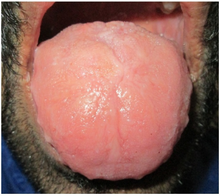| Crenated tongue | |
|---|---|
| Other names | Scalloped tongue, pie crust tongue, lingua indentata, or crenulated tongue |
 | |
| Macroglossia with crenations along the margins and loss of papillae on dorsum surface of the tongue. | |
| Specialty | ENT surgery |
Crenated tongue is a descriptive term for the appearance of the tongue when there are indentations along the lateral borders (the sides), as the result of compression of the tongue against the adjacent teeth.
The oral mucosa in the area of crenation is usually of normal color, but there may be erythema (redness) if exposed to a high degree of friction or pressure. Crenated tongue is usually asymptomatic and harmless.
It is not a disease as such, but usually results from habits where the tongue is pressed against the lingual surfaces (the side facing the tongue) of the dental arches, or from any cause of macroglossia (enlarged tongue), which in itself has many causes such as Down syndrome.
Where crenation is caused by parafunctional habits, there may also be associated bruxism, linea alba, or morsicatio buccarum.
Society and culture
In traditional Chinese medicine, scalloping of the tongue is said to indicate qi vacuity. In some homeopathic sources, scalloping of the tongue is said to be indicative of high blood pressure. Both claims are unsupported by evidence.
See also
References
- Tyldesley WR, Field A, Longman L (2003). Tyldesley's Oral medicine (5th ed.). Oxford: Oxford University Press. p. 195. ISBN 0192631470.
- ^ Laskaris, George (2003). Color atlas of oral diseases (3. ed., rev. and expanded. ed.). Stuttgart : Thieme. p. 126. ISBN 9781588901385.
- ^ Ghom (2005). Textbook of Oral Medicine. Jaypee Brothers Publishers. p. 477. ISBN 9788180614316.
- ^ Ireland, Robert (2010). A Dictionary of Dentistry. Oxford: OUP Oxford. ISBN 9780191585029.
- Heasman P, ed. (2008). Master Dentistry Vol I: Restorative dentistry, paediatric dentistry and orthodontics (2nd ed.). Edinburgh: Churchill Livingstone. p. 177. ISBN 9780443068959.
- Marnae C. Ergil; Kevin V. Ergil, eds. (2009). Pocket Atlas of Chinese Medicine. Thieme. ISBN 9783131416117.
- McCabe, Vinton (24 February 2011). Household Homeopathy. ISBN 9781458794741.
External links
| Classification | D |
|---|